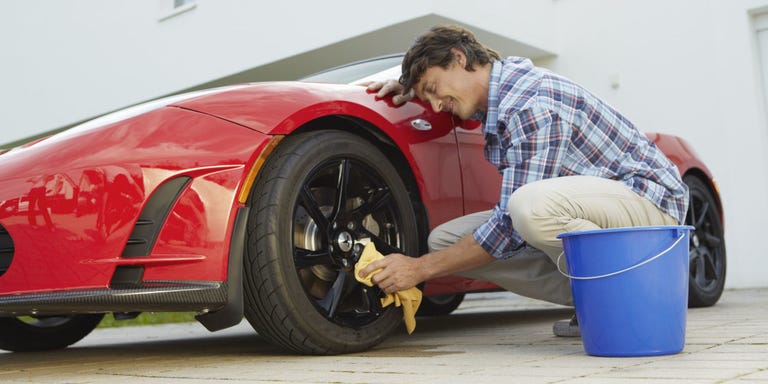Hi guys, setelah sebelumnya kami berbagi tentang bank soal Descriptive Text, maka kali ini kami juga akan berbagi dengan anda Bank Soal Procedure Text yang bisa anda gunakan sebagai bahan belajar maupun mengajar untuk mengasah kemampuan siswa anda memahami text bahasa Inggris dalam bentuk Teks Procedure.
Semoga bermanfaat, kami tunggu feedback dari anda selalu..
How
to make a French toast
Recipe for French Toast
You are going to need:
4 pieces of bread
1 spoon of sugar
2 eggs
A quarter of a cup of milk
Butter
Pan
Fork
Bowl
Before you start to cook, you have to
read the recipe.
Now you can get ready. After you read
the recipe, put everything on the counter.
When everything is ready, break the
eggs, pour a quarter of the milk in the bowl, then add a small spoon of sugar.
Mix the eggs, milk and sugar.
Next, put a piece of bread in the bowl
with the eggs, milk and sugar. Turn over the bread.
Now, put some butter in the pan. Turn
on the stove. When the pan is hot, take the bread out of the bowl and put it
into the pan. After you cook one side of the bread, cook the other side. After
you finish the first place of the bread, cook the other pieces. Now you have
French toast!
Choose the best answer.
1. The
type of the text above is called …..
A. Recount
B. Narrative
C. Description
D. Procedure
E. Report
2. The
purpose of the text is ……..
A. to describe French
toast
B. to explain about
French toast
C. to tell the reader
how to make French toast
D. to entertain the
reader with French toast
E. to persuade the
reader to make French toast
3. Who
is the text better addressed to?
A. An expert chef
B. A student learning
at home
C. A husband left by
his wife
D. A mother at home
E. A boy/girl left by
his /her mother
4. “Before
you start to cook, you have to read the recipe.” The underlined word means …….
A. a set of learning
instruction
B. a written statement
that one has received money
C. a written statement
that one has received something
D. a doctor’s written
order for a particular medicine
E. a set of cooking
instruction
5. “You
are going to need.” The expression and what it follows belong to …..
A. event
B. steps
C. materials
D. purpose
E. orientation
Making
an Omelette
This is the way an omelette should be
made. It is important that the frying-pan should be proportionate to the number
of eggs; in other word, to the size of the omelette. The frying-pan must be
made of iron not of aluminum, tin or enamel. And here I fell I must
stress a point, essential to what might be called the background of
omelette-making, namely that the frying-pan must never be washed with water but
rubbed, when hot, with salt and tissue paper, as this is the only way to
prevent sticking.
For three paper, we take six eggs,
break them into a bowl, season them with salt and freshly ground pepper, and
add a good teaspoonful of water. We beat this lightly with a fork or the
wire-broom, not the whisk, until large bubbles from on the top. This takes half
a minute; it is fatal to beat too long. Meanwhile, our frying-pan is getting
hit, not too hot, and we drop in an ounce and a half of butter and best lard,
over quick flame for a minute or two, until it gives no more froth and has
turned light golden. We give our egg-mixture another stir and pour it into the
fat, letting it spread evenly over the frying-pan.
All this is a swift business, and we
may well feel a few extra hearts-beats and a little breathlessness at that
moment. the flame is now turned down a little. With a fork or palette-knife (a
fork seems to work particularly well) we loosen the edges of the omeletee all
round and, once or twice, in the middle, letting the liquid flow into the empty
spaces, taking care always to move towards the middle.
This takes about two minutes. Then,
keeping as calm as we possibly can, we fold it. This is easiest if we fold over
and pin down with two or three fork-pricks about an inch and-a-half of the
omelette along one side. Then it is quite easy to roll it into shape. Our
omelette should be golden brown outside, and wet inside : because, as is the
classical french term. It is then slid on to a hot plate and its surface made
shiny with a little butter. This last touch makes all the difference.
1. What is important about the frying-pan?
a. It should be the same size as the eggs.
b. It should never be a small one.
c.
It should never be too small to hold
the eggs.
d. It should never be a very flat one.
e.
It should be a big one.
2. Which of the following frying-pans is
among those mentioned by the writer?
a. One made of aluminum.
b. One made of aluminum and enamel.
c.
One made of iron.
d. One made of gold.
e.
One made of paper.
3. What is the only way to prevent
sticking?
a. Rubbing with hot salt and tissue-paper.
b. Rubbing with hot water.
c.
Rubbing with salt and paper.
d. Washing with salt and paper.
e.
Washing with water.
4. When the writer uses the word baveuse,
she means ______.
a. the states of an omelette
b. an omelette made in ancient Rome
c.
the size of an omelette
d. the shape of an omelette
e.
an omelette made in France
5. Where the empty spaces we let the
liquid flow into?
a. all round the edged of the omelette
b. at some edges of the omelette
c.
in and round the pan
d. in the omelette
e.
around the pan
6. What makes all the difference to the
omelette?
a. making a plate shiny with a little
butter
b. putting something on it
c.
touching the omelette
d. sliding the omelette on to a plate
e.
putting the omelette on butter
APPLE MUFFINS
Ingredients:
· 1 cup whole meal self-raising flour
· ½ cup brown sugar
· ½ cup oat bran
· ½ teaspoon cinnamon
· ¼ cup almond flakes
· 2 large green apples
· 1 egg
· 2/3 cup milk
· 60 g butter, melted
1
Turn oven to 220oC (425oF).
2
Grease 12 muffin pans.
3
Sift flour into a bowl. Add sugar, oat
bran, cinnamon and almonds.
4
Peel and grate the apples.
5
Put them into the bowl.
6
Mix egg, milk and melted butter in a
jug.
7
Add to bowl all at once.
8
Stir with a fork
9
Stir until just mixed.
10 Almost fill the muffin pans with the
batter.
11 Bake in oven for 15 to 20 minutes until
golden.
12 Serve the muffins warm with butter and
jam.
7. When do you consider that the muffins
should be served?
a. when they are still warm
b. when they are still cold
c.
when they are in the oven
d. when they are in the bowl
e.
when they are ripe
8. Why do people use self-raising flour?
Because …..
a. you don’t have to use fork
b. you don’t have to use butter
c.
you don’t have to use cinnamon
d. you don’t have to use baking powder
e.
you don’t have to use oven
9. How many muffins will you get out of
the recipe?
a. fifteen muffins
b. fifty muffins
c.
twenty muffins
d. two muffins
e.
twelve muffins
10. What do you think ‘almost fill the
muffin pans’ means? It means …..
a. we don’t fill the pans with the muffin
b. we don’t fill the pans to the brim
c.
we don’t fill the pans with the apple
d. we don’t fill the pans to the bowl
e.
we don’t fill the pans to the oven
11. How long do you bake the muffin?
a. fifteen to twelve minutes
b. fifty to twenty minutes
c.
fifty to twelve minutes
d. fifteen to twenty minutes
e.
twelve to fifty minutes
12. Where do you cook the muffins?
a. in a bowl
b. in a teaspoon
c.
in an oven
d. in a jug
e.
in a fork








